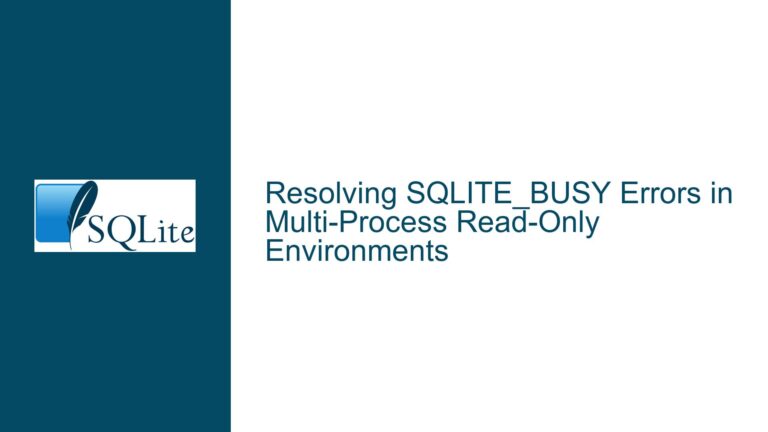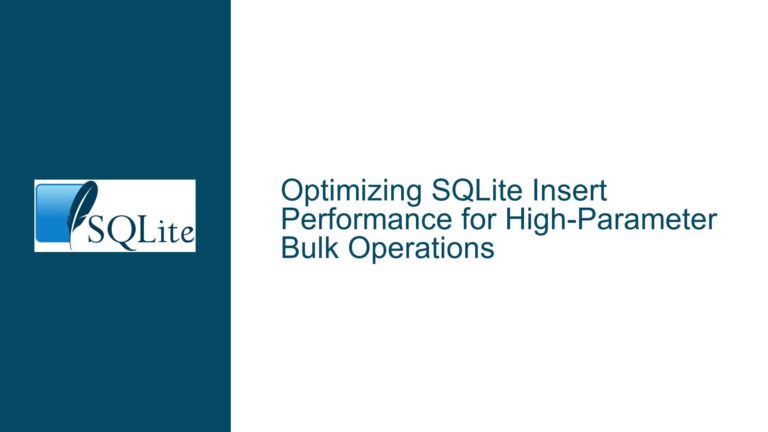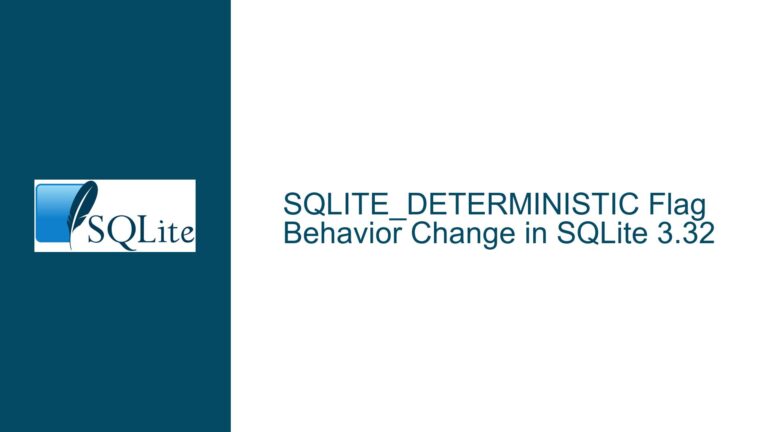SQLite B-Tree Leaf Page Overflow and balance_quick() Behavior
Issue Overview: B-Tree Leaf Page Overflow and balance_quick() Behavior in SQLite
When inserting a new record into an SQLite database, the operation may trigger a page overflow if the record size exceeds the available space on the target leaf page. In such cases, SQLite employs a mechanism called balance_quick() to handle the overflow. This function creates a new leaf page to accommodate the overflow cell, placing it as the rightmost leaf page in the B-tree structure. However, this new leaf page contains only one cell—the overflow cell—which raises questions about its compliance with the typical B-tree properties.
In a standard m-way B-tree, the number of cells in a leaf page is expected to fall within a specific range, typically between (m/2 - 1) and (m - 1). This range ensures balanced tree structure and optimal performance for search, insert, and delete operations. The presence of a leaf page with only one cell seems to violate this rule, leading to concerns about the integrity and efficiency of the B-tree.
Additionally, the SQLite database file header includes a parameter called Min leaf payload fraction, which defines the minimum fraction of space that must be occupied by payload data in a leaf page. However, there is no corresponding Max leaf payload fraction parameter, which further complicates the understanding of how SQLite manages leaf page capacity and overflow scenarios.
This issue is particularly relevant for developers and database administrators who are optimizing SQLite databases for performance and storage efficiency. Understanding the behavior of balance_quick() and the constraints of B-tree leaf pages is crucial for diagnosing potential performance bottlenecks and ensuring the database operates within expected parameters.
Possible Causes: Why balance_quick() Creates a Single-Cell Leaf Page
The creation of a single-cell leaf page by balance_quick() can be attributed to several factors related to SQLite’s internal mechanisms and B-tree management strategies. Below, we explore the most likely causes:
Page Size and Payload Fraction Constraints: SQLite uses a fixed page size, typically 4 KB, but configurable up to 64 KB. Each page must adhere to the
Min leaf payload fractionparameter, which ensures that a minimum percentage of the page is occupied by payload data. When an insert operation causes a page to exceed its capacity, SQLite must split the page to maintain this constraint. However, the absence of aMax leaf payload fractionmeans there is no upper limit on how much of the page can be occupied by a single cell. This can lead to scenarios where a new leaf page contains only one cell, especially if that cell is large.B-Tree Balancing Logic: The
balance_quick()function is designed to quickly resolve page overflow by redistributing cells or creating new pages. In some cases, redistributing cells among existing pages may not be feasible due to space constraints or the size of the overflow cell. As a result,balance_quick()opts to create a new leaf page and place the overflow cell there. This approach prioritizes speed and simplicity over strict adherence to B-tree balancing rules, which may explain why the new leaf page contains only one cell.Rightmost Leaf Page Optimization: SQLite may treat the rightmost leaf page differently from other leaf pages in the B-tree. The rightmost leaf page is often the target for new insertions, as it represents the end of the key range. By placing the overflow cell in a new rightmost leaf page, SQLite ensures that subsequent insertions can proceed without further page splits, at least temporarily. This optimization may result in a single-cell leaf page, but it can improve overall insertion performance.
Large Cell Sizes: If the inserted record is exceptionally large, it may not fit on any existing leaf page, even after redistribution. In such cases,
balance_quick()has no choice but to create a new leaf page specifically for this cell. This scenario is more likely to occur in databases with variable-length records or large binary data.Database Configuration and Usage Patterns: The behavior of
balance_quick()can also be influenced by the specific configuration and usage patterns of the database. For example, databases with high write throughput or frequent large inserts may experience more frequent page overflows and single-cell leaf pages. Additionally, the choice of page size and other configuration parameters can impact how often this issue occurs.
Troubleshooting Steps, Solutions & Fixes: Addressing Single-Cell Leaf Pages in SQLite
To address the issue of single-cell leaf pages created by balance_quick(), developers and database administrators can take several steps to diagnose, mitigate, and resolve the problem. Below, we outline a comprehensive approach to troubleshooting and fixing this issue:
Analyze Database Schema and Usage Patterns: Begin by examining the database schema and usage patterns to identify potential causes of large cell sizes or frequent page overflows. Look for tables with variable-length columns, such as
TEXTorBLOB, which are more likely to produce large cells. Additionally, review the application’s insert patterns to determine if large records are being inserted frequently.Optimize Page Size and Configuration: Consider adjusting the page size of the SQLite database to better accommodate the typical record size. A larger page size can reduce the likelihood of page overflows and single-cell leaf pages, but it may also increase memory usage and I/O overhead. Experiment with different page sizes to find the optimal balance for your workload.
Monitor B-Tree Structure and Page Utilization: Use SQLite’s built-in tools and queries to monitor the B-tree structure and page utilization. For example, the
sqlite3_analyzertool provides detailed information about page usage, including the number of cells per page and the payload fraction. This data can help identify pages with low cell counts and guide optimization efforts.Implement Record Size Limits: If large records are causing frequent page overflows, consider implementing size limits for certain columns or records. For example, you could enforce a maximum size for
BLOBcolumns or split large records into smaller chunks. This approach can help maintain a more balanced B-tree structure and reduce the occurrence of single-cell leaf pages.Reorganize the Database: In some cases, reorganizing the database can help resolve issues with single-cell leaf pages. For example, you can use the
VACUUMcommand to rebuild the database file and optimize the B-tree structure. This process redistributes cells across pages and may eliminate single-cell leaf pages.Review and Adjust balance_quick() Behavior: If the issue persists, consider reviewing the source code of SQLite to understand the specific behavior of
balance_quick(). While modifying the SQLite source code is not recommended for most users, advanced developers may be able to implement custom optimizations or workarounds for specific use cases.Consider Alternative Database Solutions: If the issue is severe and cannot be resolved within SQLite, consider exploring alternative database solutions that may better handle large records or high write throughput. For example, a database with support for dynamic page sizes or more advanced B-tree balancing algorithms may be better suited to your needs.
Consult SQLite Documentation and Community: Finally, consult the official SQLite documentation and community forums for additional guidance and best practices. The SQLite community is active and knowledgeable, and you may find valuable insights or solutions from other users who have faced similar issues.
By following these steps, you can effectively diagnose and address the issue of single-cell leaf pages in SQLite, ensuring optimal performance and storage efficiency for your database.






